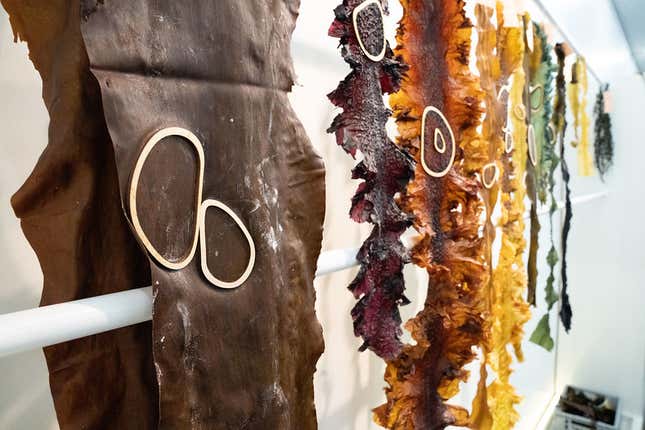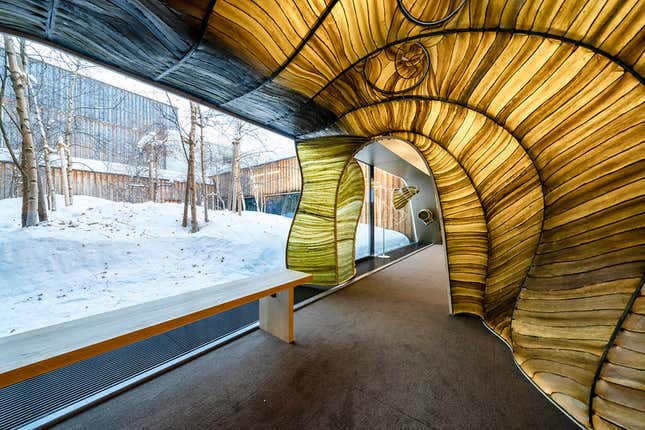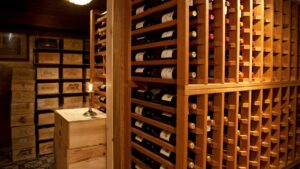
Consumerism but make it seaweed
It was 2019, London, a starting line arranged along the Thames. And as red-faced racers sprinted and stretched through the course, a crew of sideliners offered relief in a petit package: rather than plastic water bottles or paper cups, drinks were dispensed in palm-sized pods. The clear capsules were edible, biodegradable, a grab-and-go alternative to landfill fodder. And they came courtesy of seaweed.
Slick, slimy seaweed isn’t just being reimagined for the running class. Macroalgae, as some might say, is having a moment among those interested in countering climate change. A surge of upstarts are mapping out seaweed farms to capture carbon from the atmosphere. Others are seeking seaweed to slash earth-warming emissions and steady ocean acids. Still others are incorporating algaes in art and design, exploring how seaweed could become a sustainable substitute in our everyday products.
In that last vision, we’ll switch on lamps fitted with laser-cut seaweed lace, or pen Christmas cards on seaweed-speckled paper. We’ll pack biodegradable sea-cutlery for a picnic, or pluck algae-yarn sweaters off the department store rack. The hottest new commodities on the market, it seems, could be made of kelp.
But is seaweed any salve for climate crisis—or, at the least, coming to a store inventory near you? Let’s dive under the surface.
By the digits
50%: Amount of the earth’s oxygen generated by seaweed
6-7.2 million square km (3.7-4.5 sq mi): Estimated size of the world’s seaweed forests, which absorb as much carbon as the Amazon
2,000 sq km (1,240 sq mi): Space occupied by seaweed farms in the world
1 million sq km (386,000 sq mi): Space that would need to be farmed to remove a billion tons of atmospheric carbon dioxide in a year, according to one study
2.5-13 billion tons: Amount of atmospheric carbon dioxide we’d need to capture to meet climate goals
$11.8 billion: Potential value of 10 emerging global seaweed markets by 2030, according to the World Bank
🎧 Listen up
The Quartz Obsession podcast is back for Season 6!
In Seaweed: It’s always greener, Gabriela Riccardi dives deep with host Heather Landy into everything macroalgae can offer us, if we can use technology, creativity, and good old smarts to put it to work effectively.
🎧 Listen now on Spotify | Apple | Google | Pandora
Is seaweed any match for climate change?
Just like their land-bound cousins, marine plants use photosynthesis to apprehend nature’s most wanted greenhouse gas: carbon dioxide, the single-greatest contributor to global warming.
While most plants photosynthesize with their leaves, seaweed does so with all of its cells, like a powerful SeaVac sucking up and trapping mass amounts of carbon. Once seaweed locks in CO2, there’s little escape: Wetsuit-wearing researchers recently discovered that seagrasses can store carbon for centuries.
Because seaweed is so effective at carbon capture, a sweep of climate research—and funding—is examining whether more of it could mitigate global warming. Enter seaweed farming, where macroalgae is grown as a marine crop.
Traditionally, seaweed has come from Asian nations: last year, Asia produced 98% of the globe’s farmed seaweed. Now seaweed farms are cropping up around the world. They’re off the coasts of Maine, around Australia, and in the seas of Scandinavia; in the last decade, the world’s production has grown nearly 75%.
But some scientists are urging against rushing to scale up seaweed production before all its risks have been weighed. Running ahead, they warn, could imperil marine habitats, cause unforeseen ocean damage, or replicate some of the issues we face with farming on land. Seaweed production is a case for “cautious optimism,” as the United Nations puts it—emphasis on cautious.
All the goods getting an algae update
So climate-minded aesthetes have come for kelp—and before long, you might have your hands on your own sea products.
👗 Fashion wares. Algae-based textiles are coming to runway collections. One major maker is Germany’s SeaCell, which harvests seaweed every four years from Icelandic fjords to engineer kelp-based fiber. For now, seaweed is typically blended with other natural threads, like organic cotton, to create fabrics. The aim’s to eventually emerge with a textile made of 100% seaweed.
🧪 Inks and dyes. Consumer dyes are high in pollutants. Countering that are biomaterials developers like Living Ink, which specializes in black algae-based pigments, and small labs like Zeefier, which extract natural textile dyes entirely from seaweed. Shades aren’t limited to mossy greens and browns, either—Zeefier’s inks have produced soft pinks and pebbly purples, too.
🐣 Diapers. Micro-sized consumers can get a seaweed wearable, too. Designed by Berlin-based Luisa Kahlfeldt, Sumo’s collection of cloth diapers are made from a seaweed and eucalyptus textile. Unlike most reusable diapers, they don’t use polyester or polyurethane—which means they can actually biodegrade.
Pop quiz

Centuries ago, a cadre of ancient conquerors slumbered under seaweed roofs. Which group were they?
A. The Romans
B. The Huns
C. The Vikings
D. The Moors
Don’t doze off under a bed of green just yet, the answer’s at the bottom!
Place of interest
The Department of Seaweed
Julia Lohmann found her work’s future in a fish market. The Finland-based designer and researcher was carrying out a residency in Sapporo, Japan when she encountered ribbons of an edible seaweed, called kombu, folded in a market stall. The kombu was “gorgeous, like veneer or wood,” she recalls. Perhaps, she thought, it might be used as a design material.
In 2013, Lohmann formed The Department of Seaweed, a design collective dedicated to kelpy concoctions, and began experimenting with stretching and treating seaweed to eventually replace leather and plastic. Early pieces include curved kelp collars and lacy seaweed lampshades.
Today, Lohmann focuses on assembling large-scale structures, like this soaring, sculptural pavilion constructed with cured seaweed strips; the piece was presented at 2020’s World Economic Forum, where visitors could pause for a moment of zen (and contemplate protecting the climate).
Take me down this 🤿 hole!
The haenyeo, or sea women, of South Korea
Off the southern coast of South Korea, a centuries-old tradition is carried out—that of the haenyeo, the women who forage for wild seaweed and other marine life in the nation’s cold, tumbling waters. The female divers plunge up to 10 meters below the sea’s surface for their harvest, all without the help of oxygen masks—and as the practice disappears, some carry on their work well into their late years.
Take Soon-ok Goh, a septuagenarian who’s been diving since she was nine years old. Goh ventures into the ocean with bright yellow flippers and her pearly-pink pocket knife, returning with baskets of sea urchins and sea snails and kelp called miyeok. “People who do this kind of work are disappearing,” she told The New York Times this year. “When I’m done, no one will do it.”
Between 2012 and 2014, Seoul-based photographer Hyung S. Kim visited the haenyeo of Jeju Island to document the sea women at work. See her portraits here.
Poll

Have you been convinced to splurge on some algae?
🪡 Sign me up for seaweed scarves
✏️ It’s seaweed stationery for me
⛔️ I prefer my products landlocked
Let us know what your next big seaweed purchase will—or won’t—be.
💬 Let’s talk!
In last week’s poll about sectors, most of you (60%) said you think there should be a gig economy services/Substack sector in the S&P 500. But 30% think “Weird crap you buy on Amazon at 2am” is the missing 12th sector.
🐤 X this!
🤔 What did you think of today’s email?
💡 What should we obsess over next?
Today’s email was written by Gabriela Riccardi (would rock a kelp sweater) and edited and produced by Morgan Haefner (would eat a seaweed salad).
The correct answer is C., the Vikings. In centuries past, residents on the Danish island of Læsø thatched their roofs with eelgrass. Today, architects and designers alike are looking to the Viking practice to turn seagrass into contemporary building materials—no horned helmets required.





